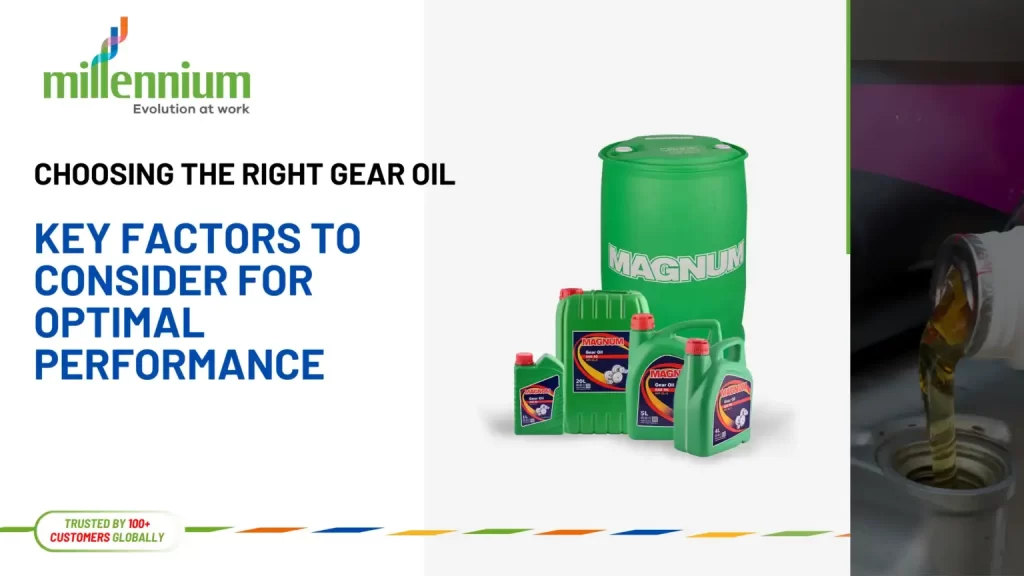Gear oil plays a critical role in ensuring the smooth operation and longevity of gears in various machinery and vehicles. Whether for industrial applications or automotive systems, choosing the right gear oil is essential to prevent wear, reduce friction, and ensure reliable performance. However, selecting the appropriate lubricant can be complex, as it depends on factors such as load conditions, operating temperatures, and the type of gears in use. This guide will help you navigate the decision-making process by focusing on how to choose the right gear oil, the defining factors for its application, tips for selection, and the importance of gear lubricant maintenance.
How to Choose the Right Gear Oil?
Selecting the correct gear oil begins with understanding the specific requirements of your machinery or vehicle. Gear oils are specially formulated to handle high-pressure conditions between metal surfaces. The right oil not only ensures smooth gear operation but also protects against wear, corrosion, and overheating.
Start by consulting the manufacturer’s recommendations, which usually specify the required viscosity and performance standards for the gear oil. For example, automotive gear oils are often classified according to the American Petroleum Institute (API) GL standards, ranging from GL-1 for light-duty applications to GL-6 for extreme conditions. Additionally, understanding whether your gear system operates in high-speed, low-torque conditions or low-speed, high-torque environments can guide your choice of oil type.
Factors that Define the Right Gear Oil for Application
1. Viscosity
Viscosity is the most crucial factor in gear oil selection. It refers to the oil’s resistance to flow and is directly related to its ability to form a lubricating film between moving parts. Lower viscosity oils are suitable for high-speed applications with low loads, while high-viscosity oils are ideal for heavy-load, low-speed operations. Ensuring the correct viscosity is critical to prevent metal-to-metal contact and excessive friction.
2. Load-Carrying Capacity
Gear systems that operate under heavy loads require oils with extreme pressure (EP) additives. These additives form a protective film on metal surfaces, reducing wear and preventing pitting under high-pressure conditions. EP additives are particularly essential for gears such as hypoid gears in automotive axles.
3. Operating Temperatures
Gear oils must perform well across a range of operating temperatures. In applications involving high heat, thermal stability is essential to prevent oil degradation. Conversely, in cold environments, the oil must remain fluid enough to provide adequate lubrication. Multi-grade gear oils, which offer a broader temperature range of performance, are often the best choice for such conditions.
4. Compatibility with Gear Type
Different gear types have specific lubrication needs. Spur gears, helical gears, and bevel gears typically have lower lubrication demands compared to worm or hypoid gears, which operate under higher sliding friction. Worm gears, in particular, benefit from lubricants with high film strength and anti-wear properties to handle their unique stress patterns.
5. Corrosion and Oxidation Resistance
Gear oils should include additives that protect metal surfaces from corrosion caused by moisture or chemical reactions. Oxidation inhibitors are also important, as they prevent the formation of sludge and varnish that can degrade the oil’s performance over time.
Tips for Choosing the Right Gear Oil Lubricant
Tips for Choosing Right Gear Oil Lubricant – selecting the ideal gear oil lubricant involves careful consideration of your application’s demands and the oil’s properties. Always ensure that the oil meets industry standards such as ISO, AGMA, or API classifications. Choose synthetic gear oils for applications requiring enhanced performance under extreme conditions, as they offer superior thermal stability, reduced friction, and longer service intervals compared to mineral-based oils. Additionally, if your system operates in an environment with water exposure, opt for gear oils with excellent demulsification properties to separate water effectively.
Understanding the operational environment is equally important. For example, machinery in dusty or contaminated conditions may benefit from gear oils with enhanced detergency to keep the system clean. If noise reduction is a concern, as in automotive applications, selecting oils with noise-dampening additives can improve user comfort.
Gear Lubricant Maintenance
Choosing the right gear oil is only the first step; maintaining its quality and effectiveness is equally crucial. Regular oil analysis helps monitor the lubricant’s condition, identifying contaminants, wear particles, and additive depletion. Such analysis can prevent premature gear failure by allowing timely intervention.
Proper storage and handling of gear oils are also essential to preserve their quality. Store them in clean, dry areas away from extreme temperatures. During oil changes, ensure the system is thoroughly cleaned to remove any residual contaminants that could compromise the performance of the new oil.
Routine inspections of the gear system are recommended to identify leaks, misalignments, or other mechanical issues that may stress the lubricant. Periodically replacing gear oil based on the manufacturer’s recommendations or the findings of oil analysis is vital to sustaining optimal performance and extending the lifespan of your equipment.
Conclusion
Choosing the right gear oil is critical for maintaining the efficiency and durability of your machinery or vehicle. Factors such as viscosity, load-carrying capacity, operating temperatures, and gear type must be carefully evaluated to ensure the oil meets the specific demands of your application. Following best practices for selecting and maintaining gear oil not only prevents costly downtime but also enhances overall operational reliability. By prioritizing high-quality lubricants and adhering to regular maintenance schedules, you can maximize the performance of your gear systems and ensure their long-term functionality.




